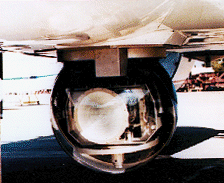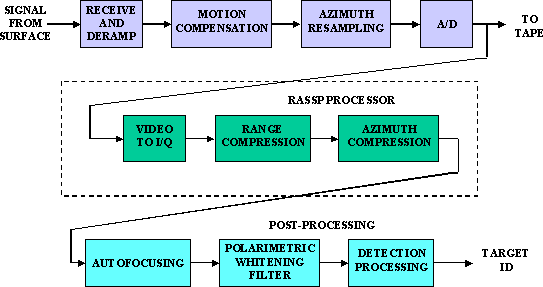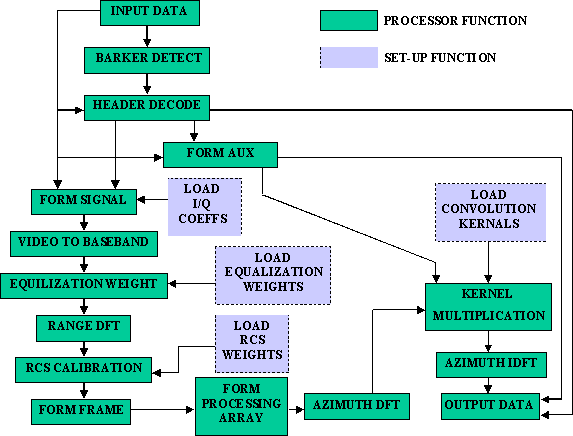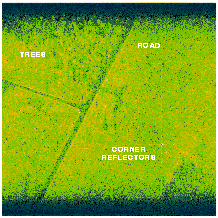Next: 3 System Design Up: Case Studies Index Previous: 1 Introduction
![]()
![]()
![]()
![]()
Next: 3 System Design
Up: Case Studies Index
Previous: 1 Introduction
For more details, go to the
Lincoln Laboratory website
The ADTS radar is a fully polarimetric, air-to-ground SAR that operates stripmap
mode with a +90-degree squint angle; that is, the radar points +90 degrees relative to
the velocity vector. The transmitter alternates between H-pol and V-pol, while
H-pol and V-pol are simultaneously processed in the receiver. The radar transmits
at a 3-kHz rate, so that the same-polarization pulse repetition frequency (PRF) is
1.5 kHz. The resolution is 0.3 meters.
The system de-ramped, down-converted, and filtered the linear frequency
modulated (LFM) pulses, providing inputs to the A/D (analog to digital) converters that
were real, uncompressed (i.e., frequency domain) data. The data corresponded to a
375-meter range swath. The system sampled pulse data using 8-bit A/D
converters at a 125-MHz rate, yielding 4064 real samples per pulse. The range
window for the radar was 468.4 meters with a 375-meter range swath at the center of
the range window. After digitization, the system compensated the phase and frequency for
non- linear motion of the aircraft and timing errors in the de-ramp process. Pulses
were also processed for Doppler and re- sampled (interpolated) to yield a constant
spatial interval of 0.2287 meters along the flight path. This represented a PRF of 437 Hz
for a nominal aircraft velocity of 100 meters/second. The output of the re-sampling
process was pulse data with 11 bits of precision.
Figure 2- 2 shows the proposed ADTS SAR processing system. Data was recorded from the original system after azimuth re-sampling and A/D conversion. With a
real-time processor, the data would be sent to the SAR signal processor as 40-bit
words transmitted serially over a fiber-optic link. In the laboratory, the recorded data
was supplied to the SAR processor from real-time source/sink test equipment. The functions implemented in the benchmark SAR processor were those inside the dashed lines of Figure 2- 2. The Team did not implement the other post-processing functions at that time, but it did size the SAR processor to provide future upgrade capability to include these
functions.
The SAR signal processor received channels of polarized pulse, header , and auxiliary
(Aux) data. A 20-word sequence indicated the start of pulse data. This sequence was a
13-word Barker code, five leading zeros, and two trailing don't-care words.
This sequence was followed by 2032 words of 11-bit even-pulse samples and
11-bit odd-pulse samples, sign extended to 12 bits. Included with the pulse samples were header and Aux data recorded in bit-serial fashion and duplicated in bit positions 3, 16, 19, and 32 of the 40-bit data word. Header data described the polarization of the pulse data, and Aux data contained ancillary navigation and radar data. Pulse data for the four polarizations were outputted in a repeated sequence; that is, ... HH, HV, VH, VV, HH, ... Aux data was only written for the leading pulse of the sequence; that is, HH. There was arbitrary length-filler data between the end-of-data for one pulse and the start sequence for the next pulse.
Because the HV and VH polarizations ideally contain the same information, the system
used at most three of the four polarizations to form images. Generally, images were formed
for the HH and VV polarizations and either the HV or the VH polarization, as established
by the operator through the RS- 232 control interface. Therefore, it was necessary
to process and retain pulse polarization information from the header. Aux data also had to
be processed to extract slant range information used by the processing.
Prior to pulse compression, the system converted 4064 real video samples of each
polarization to be imaged to in- phase and quadrature or I/Q data at baseband. The
system created the basebanding operation by forming sequences of even/odd pulse samples
and then modulating each sequence by (- 1)n. This yielded two
real-value sequences for each pulse:
The system then passed the sequence through a FIR (Finite Impulse Response) filter,
which had from 8 to 48 taps. For example, an 8- coefficient FIR filter yielded the
sequence{ si0, si1, si2, ...,
si2023}. The FIR filter output sequence was 8 samples shorter than the FIR
input sequence because the system had to initialize the filter before valid data samples were
obtained. Similarly, the odd sequence was passed through the FIR filter to yield the
sequence{ sq0, sq1, sq2, ...,
sq2023}. These sequences were combined to form the sequence of
complex samples { (si0, sq0), (si1,
sq1), ..., (si2023, sq2023)}.
During pulse compression, the system transformed the 2024 uncompressed I/Q samples of
each pulse into a compressed-range pulse with 2048 samples. Each of the 2048
samples constituted a range-gate. Pulse compression began by applying weighting to
the complex valued I/Q data. Weighting reduced the sidelobes of the compressed
pulse and was applied to the 2024 complex input samples with trailing zero-pads to
expand the data to 2048 samples. The system modulated the complex input data by
(- 1)n , where n = 0, ... , 2047, so that the compressed range pulses
were centered in the range window. The complex equalization weights were down
-loaded via the control interface to the SAR processor prior to real-time operation.
These weights were polarization-specific. Polarization designations, extracted from the
data header, had to be used to establish which set of equalization weights to apply to a
given set of data.
Weighted I/Q data was transformed to compressed range data using a 2048-point
DFT. To compensate for radar cross- section (RCS) variations from elevation
beam-shape modulation and for losses across the range swath, amplitude
weights were applied to samples of the compressed pulse. The RCS weights were
down-loaded via the control interface to the SAR processor prior to real-time
operation.
Compressed pulses were placed in time sequence in a 2-D array called a frame. Each
row of the frame contained 512 pulses and each column contained 2048 range gates. Each
frame, then, was a 2048 x 512 array. Once 512 pulses had accumulated to form a frame,
the frame was shifted into the processing array. The processing array was a 2-D array,
where azimuth compression processing was performed. The processing array consisted of
two frames and was a 2048 x 1024 array. As each new frame was shifted into the
processing array, the oldest frame was shifted out. A convolution was performed along
each row of the processing array. The convolution processing was performed using DFTs
with the overlap-save method. A 1024-point DFT of each row was multiplied
with the 1024-point DFT of the associated convolution kernel. The convolution
kernels were 512 points long, but trailing zeros were used to pad-out the kernel to
1024 points. Each vector product was inverse transformed, and the last 512 samples of
each inverse transform represented valid convolution outputs and were saved in an image
array. A new frame was shifted into the processing array, the convolution process was
repeated, and more data was added to the image array, thereby generating the output SAR
image.
The convolution kernel used for each row was selected from a database of 31
pre-calculated kernels, where the kernels had been Taylor weighted, zero padded, and
Fourier transformed. The choice of kernel was determined by the slant range to the middle
of the most recent frame in the processing array. This slant range was contained in the Aux
record of the 256th pulse of the most recent frame. The kernels were calculated based on
the slant range to the middle of the first frame of data obtained for a given pass, and they
were stored for use throughout the pass. Only 16 of the 31 stored kernels were used at one
time in azimuth compression, but the 16 vary with each frame. See Figure 2- 4 for
an example SAR image output.
The system architecture had to be scalable to support at least twice the processing and twice
the aggregate communication bandwidth as that implemented in the initial configuration. In
addition to space for future expansion in the algorithm, room also had to be available in the
processor box for the addition of a 4-slot 6U VME chassis. The provision for a VME
chassis, or availability of four contiguous slots in an existing internal chassis, was to
enable the use of commercial VME boards for display or subsequent processing of the
images.
The weight for a fully loaded chassis, including the 4 slot VME chassis, was not to exceed
60 pounds. Air cooling in a non-condensing environment was used, and the
temperature range of the ambient air was 0o C to 40o C.
The SAR processor power supply had an input voltage of 24 to 32 volts DC, with average
input power not exceeding 500 watts in the baseline system and 750 watts in the fully
expanded system.
Lincoln Laboratory had a non real-time implementation of the image formation
algorithm that ran on a workstation. The images formed using this implementation were
outputted in 32-bit IEEE floating point and represented the basis for acceptance testing
of the SAR processor. To verify adequate processor dynamic range and accuracy, the Team
calculated differences among corresponding pixels in a processed SAR image, Xsar, and
MIT/LL's reference SAR image, Xref. The power of the error due to processing,
Perr, had to be less then 103 dB relative to the maximum output signal power, Pmax, or
10log(Perr/Pmax)=10log((abs(Xsar-Xref)**2)/2Pmax)< - 103
The output data format for each polarization processed consisted of an image frame header
followed by the complex samples from each image. There was a maximum of three
polarizations imaged per frame.
2.0 Overview of the Problem with the Synthetic Aperture Array
System
The problem MIT Lincoln Laboratory (MIT/LL) defined for Benchmark 1 was the design
and construction of a real- time synthetic aperture radar (SAR) processor for the
formation of images on board an unmanned air vehicle (UAV). The SAR is an important
tool for the collection of high-resolution, all-weather image data and has
application in tactical military systems as well as civilian systems for remote sensing. It can
also be used to identify man-made objects on the ground or in the air.
2.1 Synthetic Aperture Array System
The SAR processor had to be compatible with MIT/LL's Advanced Detection
Technology Sensor (ADTS) (Figure 2- 1). The intent was to interface SAR's
real-time image processor directly to the ADTS system without
modifying existing data formats or timing in the ADTS system. Because the ADTS system had been operational for several years, recorded data was available for test purposes. The
ADTS system consisted of a Ka-band SAR sensor, navigation, and recording system.


2.2 Synthetic Aperture Radar Processing Algorithms
During operation, the SAR processor continuously formed images for up to three, user
selectable, polarizations. Figure 2- 3 shows the processing flow. In addition to the
continuous process of image formation, there was a setup process prior to processing the
first PRI of data that loaded the required parameters.

where sn is the nth real sample.
A detailed description of the processing is contained in in
the MIT Lincoln
Laboratory paper [Zuerndorfer94] 
2.3 Form Factor Constraints
The maximum allowable dimensions for the processor were 10.5," 20.5," and 17.5."
These dimensions encompass chassis, cooling fans, power supply, and cable headers and
were consistent with the use of the processor on board the Amber UAV. The Amber is a
long endurance UAV produced by Leading Systems, Inc., during the 1980s. It is
approximately 18 feet long (Figure 2- 5) and has a demonstrated flight endurance of
30 to 35 hours.

2.4 Accuracy
The SAR processing hardware was required to preserve the Signal-To-Noise ratio (SNR) in the image data and could not introduce appreciable computational noise or
artifacts into the image. The SAR processor had to support full- scale input signals
without saturation, and quantitization errors in the output data had to be 10 dB below
receiver noise. The SNR was 93 dB, and the minimum dynamic range of the SAR
processor was required to be 103 dB.
where Perr=( abs(Xsar-Xref)**2)/2
Xsar pixels in a processed SAR image
Xref pixels in MIT/LL reference SAR image
Pmax maximum output signal power of 1.4736E10**18
2.5 Latency
The SAR processor's latency was the time between an input data frame and the
corresponding output image frame. The time for the input data frame was defined by the
arrival time of the last pulse used to form the image frame. The output image time was
defined by the time when the first pixel is passed out of the processor. The latency for the
SAR processor could not exceed 3 seconds.
2.6 Data Interfaces
The data stream to/from the SAR's processor was required to be bit-serial over
fiber-optic links, compatible with the format used by the TriQuint HRC- 500FS
fiber-optic transmit/receive module. The HRC- 500FS provided a data rate of 500
Mbps.
2.7 Control and Diagnostic Interface
The SAR processor's control interface was a bi-directional RS- 232 with
preselectable baud rate. Baud rates of 9.6 kbaud and 19.2 kbaud were required with 38.4
kbaud desired. The control and diagnostic interface had to support a minimum set of
commands defined in the Benchmark Technical Description (BTD). Typical commands
included boot, run, stop, step, init, restart, load, dump, and self-test.
2.8 Summary
Item
Requirement
Represented by
Executable
Specification
Data
I/O Ports
Data Format
Y
Protocol
Y
Timing and Data Rate
Y
Physical (Fiber Cable)
N
Control Port
Commands and Behavior
Y
Data Format
Y
Protocol
Y
Timing and Data Rate
N
Physical (RS- 232)
N
Modes of Operation
Select any 1 to 3 polarizations from 4
Y
FIR filter taps (8 to 48)
Only 8
Accuracy
Maximum image error to reference files
Y
Latency
< 3 seconds
Y
Physical Constraints
Size < 10.5" x < 20.5" x < 17.5"
N
Weight < 60 pounds
N
Power < 500 Watts
N
Testability
Best Practices
N
Scalability
2X in computation and communication
N
Environment
UAV, non-condensing, air cooled
N
Production Quantity
500 units
N
![]()
![]()
![]()
![]()
Next: 3 System Design
Up: Case Studies Index
Previous: 1 Introduction